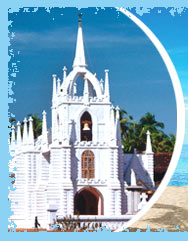 The
forts in Goa are largely a legacy of the Portuguese occupation of the
land. As the conquerors led by Albuquerque sought to expand their
territory, they erected massive forts at strategic locations so as to
ward off hostile attacks. These imposing edifices, strategically
situated at river mouths, proved to be the bulwarks against enemy
troops. But as the Portuguese gradually gave up their dominions, the Goa
forts were reduced to a state of dilapidation and ruins. In recent years
some of the forts of Goa have been refurbished as heritage hotel
properties to leverage their rich legacies. Given below are some famous
forts in Goa:
The
forts in Goa are largely a legacy of the Portuguese occupation of the
land. As the conquerors led by Albuquerque sought to expand their
territory, they erected massive forts at strategic locations so as to
ward off hostile attacks. These imposing edifices, strategically
situated at river mouths, proved to be the bulwarks against enemy
troops. But as the Portuguese gradually gave up their dominions, the Goa
forts were reduced to a state of dilapidation and ruins. In recent years
some of the forts of Goa have been refurbished as heritage hotel
properties to leverage their rich legacies. Given below are some famous
forts in Goa:Aguada Fort
An awe-inspiring edifice, the Aguada fort stands tall among the Portuguese-era forts scattered across Goa. Strategically located at the estuary of the river Mandovi, the Aguada fort is the largest among the lot. Aguada in Portuguese translates to 'water' and the fort has been called so for the spring within the ramparts that provided water supply to the ships that called here arriving after the long sea voyage from Lisbon.
Cabo Da Rama Fort
Located in the Canacona taluka of South Goa, the Cabo da Rama fort presents a desolate spectacle of crumbling ruins. Also known as Cape Rama fort, this ancient bastion is steeped in mythological legends. The fort derives its name from Rama, the protagonist of the epic Ramayana, who, accompanied by his wife Sita took refuge here during his exile from Ayodhya.
Reis Magos Fort
Built in 1551, the Reis Magos fort is another manifestation of the Portuguese rulers' resolve to defend their territory against invaders from the neigbouring states of Goa. The fort is located at the eponymous village on the northern bank of the Mandovi River. Originally built by Sultan Adil Shah, the Reis Magos fort was annexed by the Portuguese in 1760.
Terekhol Fort
Located on the northern tip of Goa at the mouth of Terekhol river, the Terekhol fort was a lynchpin of the Portuguese efforts to protect their coastline from invading armies. Originally built by Maharaja Khem Sawant Bhonsle, the Raja of Sawantwadi, in the 17th century, the Terekhol fort was extensively revamped in 1764 after the Portuguese Viceroy Dom Pedro Miguel de Almeida captured it.











